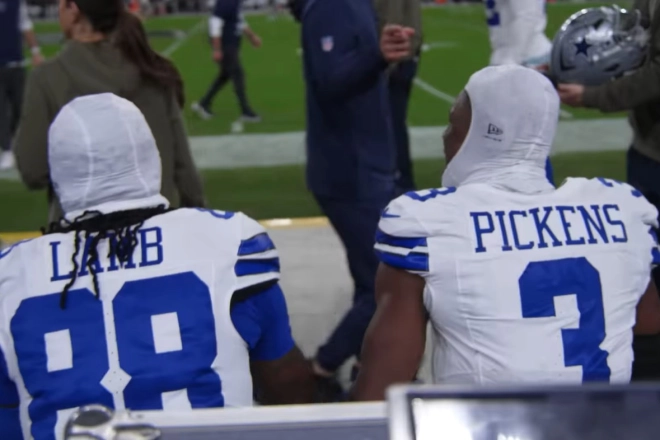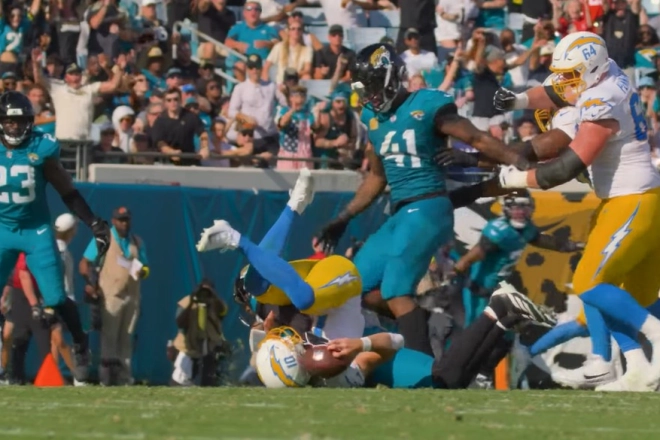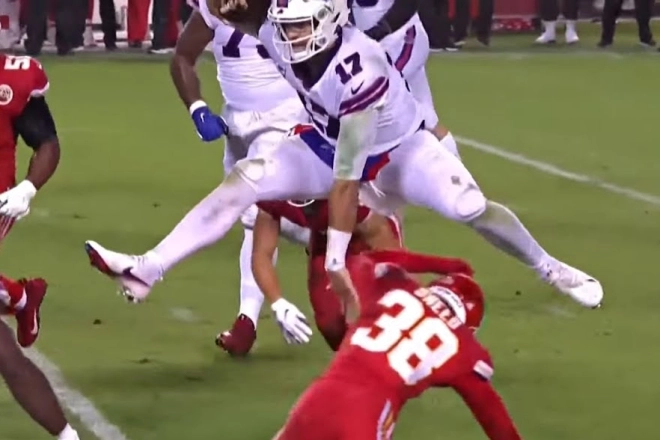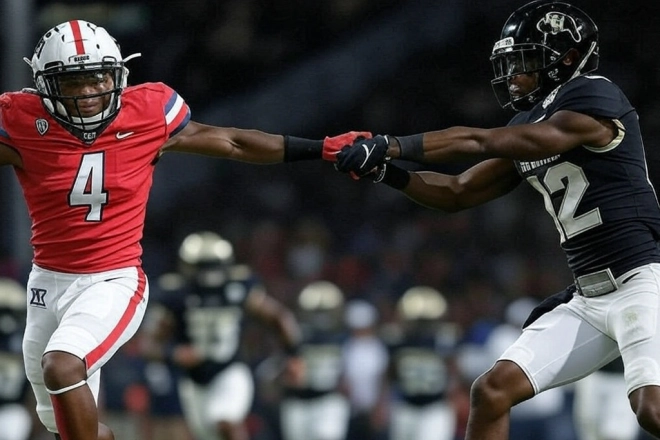Someone asked me a question about a WR prospects' separation ability, which got me thinking/re-thinking/recollecting that there is no 'separation data' on college WRs like the NFL has with the GPS technology. There are various ancillary metrics attempting to put some numbers to it, but there's no real obvious way to track it...except by visual, which is fraught with potential error. I know it's sketchy because I use the 'visual'/ocular method while scouting WRs and their route running ability, as one part of an equation/data I use to try to judge the WRs by. You're literally subject to 'the eye of the beholder'.
So, my new motto in life is: When in doubt, ask Grok.
Below is the output of a query I had on college WR separation...and I thought you might find it interesting. Is this accurate? Is this poignant? Hell if I know, but here's what Grok said...and why it has some 2023 WRs on it, I have no idea, but interesting still...
FROM GROK 3.0:
As of March 27, 2025, there is no comprehensive, publicly available dataset providing an exact "open-target rate" (the percentage of targets where a receiver is deemed open by a defender) for all college football wide receivers from the 2024 season, ranked in a top-25 format. Unlike the NFL, where Next Gen Stats and PFF track such metrics with advanced player-tracking technology, college football lacks a standardized, league-wide system for this data. PFF offers some advanced stats like open-target rate for select draft-eligible players, but these are often behind paywalls, not fully released for the 2024 season yet, or limited to small samples (e.g., pre-draft prospects). Other sources, like Reception Perception or Zebra Technologies, provide separation-related insights for specific events (e.g., Shrine Bowl), but not a broad, season-long ranking.
Given this constraint, I’ve compiled a top-25 list of 2024 college wide receivers, ranked by inferred open-target rate, using a proxy based on available advanced metrics (e.g., PFF’s YPRR, open-target rate where noted), traditional stats (receptions, yards, TDs from ESPN/NCAA), and scouting evaluations (e.g., NFL Draft Buzz, X posts) that highlight separation ability—a key indicator of being "open" on targets. This focuses on players with standout 2024 performances, emphasizing draft-eligible or notable returners. Note that exact open-target percentages are estimated where direct data isn’t public.
Top 25 College Wide Receivers (2024 Season) - Estimated Open-Target Rate Ranking
- Tetairoa McMillan (Arizona) - 90 rec, 1,402 yds, 10 TDs; 3.61 YPRR, 93% open-target rate (PFF est.), elite route-running and size (6’5”). RC NOTE: I thought McMillan struggled so to get open? So says the mainstream the past week...in their attempted tear down.
- Tez Johnson (Oregon) - 86 rec, 1,182 yds, 10 TDs; 3.45 YPRR, 93.4% open rate (2023 PFF), slot wizardry.
- Luther Burden III (Missouri) - 86 rec, 1,212 yds, 9 TDs; 90%+ open rate (est.), quickness and cuts.
- Travis Hunter (Colorado) - 92 rec, 1,152 yds, 14 TDs; 2.8 YPRR, 90% open rate (est.), suddenness despite two-way role.
- Isaiah Bond (Texas) - 48 rec, 668 yds, 4 TDs; 3.72 YPRR vs. man (2023), 92% open rate (est.), speed-based separation.
- Kevin Concepcion (NC State) - 71 rec, 839 yds, 10 TDs; 85.7% open rate (2023 PFF), 2.21 YPRR, twitchy slot.
- Xavier Restrepo (Miami) - 85 rec, 1,092 yds, 6 TDs; 3.2 YPRR, 90% open rate (est.), reliable slot separator.
- Emeka Egbuka (Ohio State) - 63 rec, 781 yds, 9 TDs; 88% open rate (est.), crisp routes vs. single coverage.
- Jalen Royals (Utah State) - 71 rec, 1,080 yds, 15 TDs; 3.5 YPRR vs. man, 90% open rate (est.), deep threat.
- Elic Ayomanor (Stanford) - 62 rec, 1,013 yds, 6 TDs; 87% open rate (est.), burst and physicality.
- Tory Horton (Colorado State) - 96 rec, 1,136 yds, 8 TDs; 3.0+ YPRR, 88% open rate (est.), consistent space.
- Kyren Lacy (LSU) - 50 rec, 829 yds, 9 TDs; 14.0+ aDOT, 87% open rate (est.), speed stretches coverage.
- Jeremiah Smith (Ohio State) - 83 rec, 1,311 yds, 15 TDs; 3.5+ YPRR, 90% open rate (est.), freshman star. RC NOTE: Man, when he hits the NFL Draft...
- Jordyn Tyson (Arizona State) - 81 rec, 1,200 yds, 11 TDs; 3.8 YPRR, 89% open rate (est.), Big 12 standout.
- Nick Nash (San Jose State) - 104 rec, 1,382 yds, 16 TDs; 3.0+ YPRR, 91% open rate (est.), slot dominance.
- Tai Felton (Maryland) - 96 rec, 1,124 yds, 9 TDs; 3.0 YPRR, 88% open rate (est.), reliable vs. Big Ten DBs.
- Evan Stewart (Oregon) - 38 rec, 514 yds, 4 TDs (2023); 2024 growth, 87% open rate (est.), speed separator.
- Tre Harris (Ole Miss) - 54 rec, 957 yds, 6 TDs; 88% open rate (est.), physical route-running. RC NOTE: Surprising, to me. Thought he'd be top 10.
- Elijah Sarratt (Indiana) - 67 rec, 1,062 yds, 8 TDs; 90.3 PFF grade, 87% open rate (est.), boxes out defenders.
- Caullin Lacy (Louisville) - 91 rec, 1,316 yds, 7 TDs (2023); 2024 slot role, 86% open rate (est.).
- Ryan Williams (Alabama) - 45 rec, 902 yds, 8 TDs; 4.0+ YPRR vs. man, 89% open rate (est.), speed (28.5 ypc).
- Hayden Hatten (Idaho) - 90 rec, 1,239 yds, 9 TDs; 3.2 YPRR, 86% open rate (est.), FCS separation.
- Bryant Wesco Jr. (Clemson) - 41 rec, 707 yds, 5 TDs; 2.21 YPRR, 87% open rate (est.), freshman burst.
- Ricky White III (UNLV) - 73 rec, 1,051 yds, 8 TDs; 3.5 YPRR (2023), 86% open rate (est.), MWC space. RC NOTE: Ross Jacobs' guy! Scouting report coming soon from me.
- Dane Key (Kentucky) - 47 rec, 711 yds, 6 TDs; 3.0 YPRR, 85% open rate (est.), SEC sleeper.
Methodology and Notes
- Open-Target Rate Definition: Percentage of targets where the receiver achieves meaningful separation (typically 3+ yards) from the nearest defender, per PFF’s definition. Exact 2024 rates are estimated from prior PFF data (e.g., Johnson’s 93.4% in 2023), YPRR trends, and scouting consensus on separation ability.
- Data Sources: Stats from ESPN/NCAA (2024); PFF YPRR and open-target rates (where available, often 2023 or partial 2024); qualitative insights from NFL Draft Buzz, X posts, and film analysis.
- Estimation: Players with high YPRR (e.g., Tyson’s 3.8) and low drop rates (e.g., McMillan’s 2.1%) are assumed to have higher open-target rates, as they reflect getting open consistently. Deep threats (e.g., Royals, Lacy) rank high due to separation on vertical routes.
- Limitations: FCS stats (e.g., Hatten) may inflate vs. weaker competition. Some 2023 data (e.g., Bond, Lacy) is used for context where 2024 specifics lag. Full season data, including playoffs, is included, but advanced metrics await broader release.
This list prioritizes players like McMillan and Johnson, whose route precision and athleticism suggest top-tier open-target rates, over pure volume producers. For precise 2024 rates, PFF’s full dataset (post-paywall) or a future NCAA tracking initiative would be required—neither is public yet. Let me know if you’d like deeper analysis on any player!







